The Microsoft Lumia 640 Review
by Brandon Chester on June 9, 2015 8:00 AM EST- Posted in
- Smartphones
- Microsoft
- Mobile
- Lumia
- windows phone 8
System Performance
Since the state of benchmarking on Windows Phone is not as mature as Android, I haven’t been able to compare the Lumia 640 to the competition in every aspect that I would like to. What I have been able to do is put it through our standard browser benchmarks, along with BaseMark OS II to look at individual component performance, and GFXBench to examine GPU performance.
While the absolute performance of Snapdragon 400 is well known, certain aspects of performance are heavily impacted by a device’s software. A good example is browser performance, which is a function of both SoC power and the speed of a device’s browser and Javascript engine. Two devices with the same SoC can have very different browser performance.
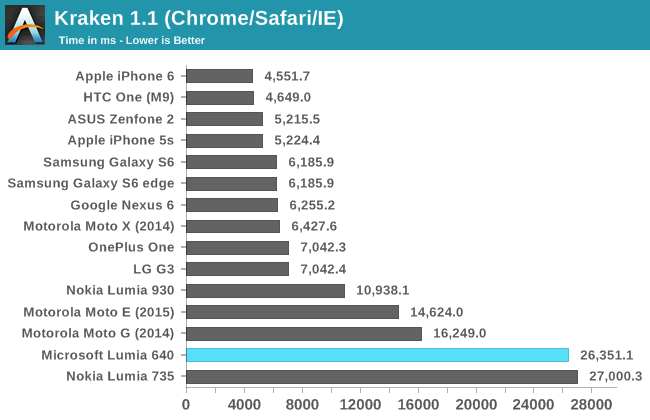
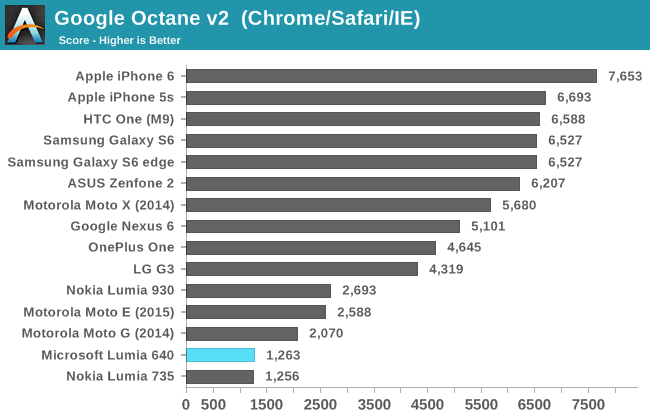
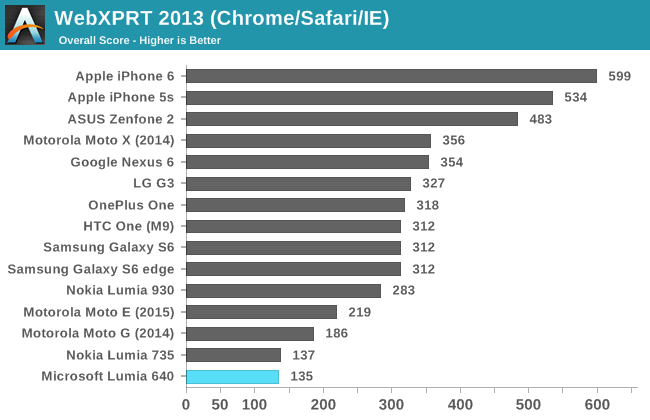
Unfortunately, it’s clear that Internet Explorer doesn’t measure up to Chrome and Safari when it comes to performance. While buyers may be pleased that their Lumia 640 performs as well as the more expensive Lumia 735, both of these phones occupy the lowest positions on every chart. There’s even a significant gap between them and other Snapdragon 400 devices running Android, such as Motorola’s Moto G.
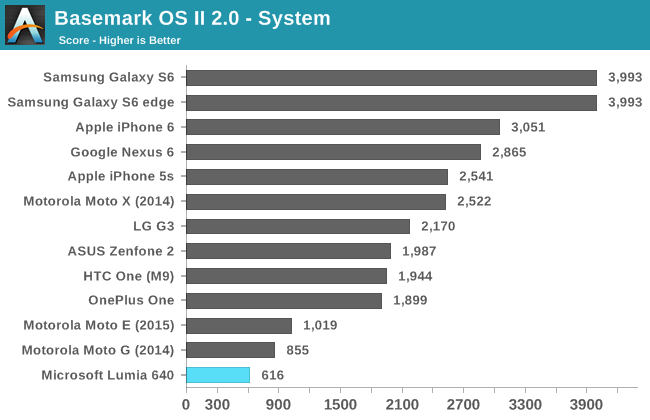
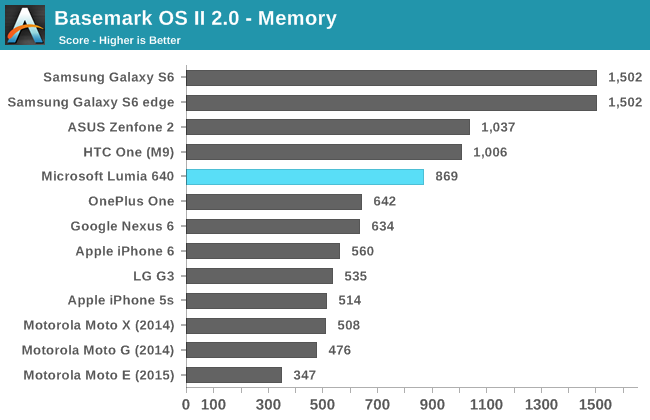


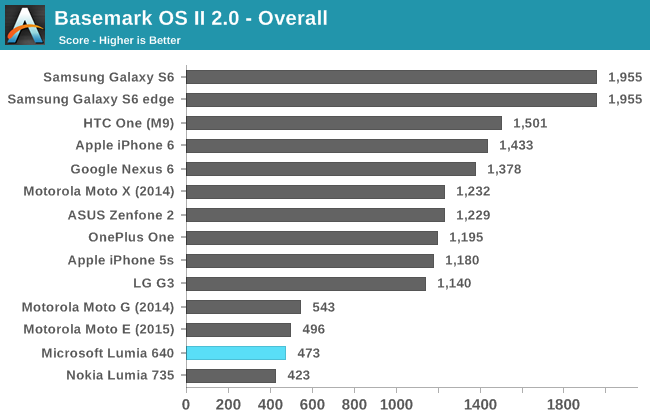
There's not much need to go into detail on the Lumia 640's performance in BaseMark OS II. With the exception of a fairly good result in the NAND memory test, the Lumia 640 achieves the lowest scores that we've seen in recent times.
Unfortunately, the Lumia 640 isn't shaping up to be a very quick device. It's consistently bested by Snapdragon 400 devices running Android, and in 2015 we're going to see Snapdragon 410 used as the SoC of choice in devices at this price bracket, which won't make the Lumia 640's position any better. Microsoft needs to iterate much quicker than they currently are. Their slow pace in adoption new hardware helped kill Windows Phone in the high end market, and it will do the same to the low end. I have some further words about performance on the Lumia 640 and Windows Phone in general, but those will have to wait until the software section of the review.
GPU Performance
The last area of performance to investigate is GPU performance. The performance of Adreno 305 has been thoroughly evaluated on Android, but differences in drivers and graphics APIs can improve or reduce performance across different operating systems.
Since Adreno 305 doesn’t support Direct3D feature level 10.0 and Shader Model 4.0 it’s unable to run the GFXBench 3.0 Manhattan test. This leaves us with only the T-Rex HD benchmark which isn’t very hard on high end devices, but still poses quite a challenge for weaker mobile GPUs.
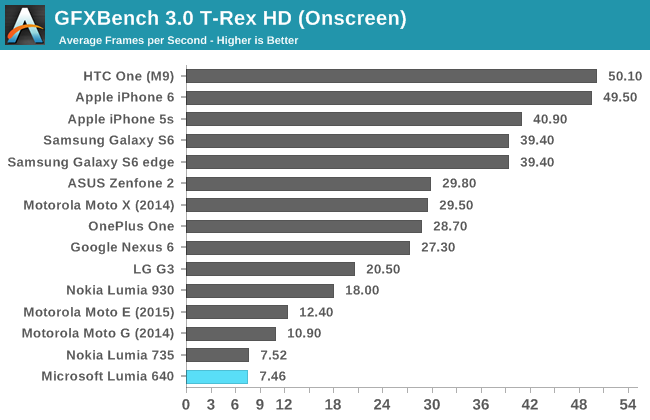
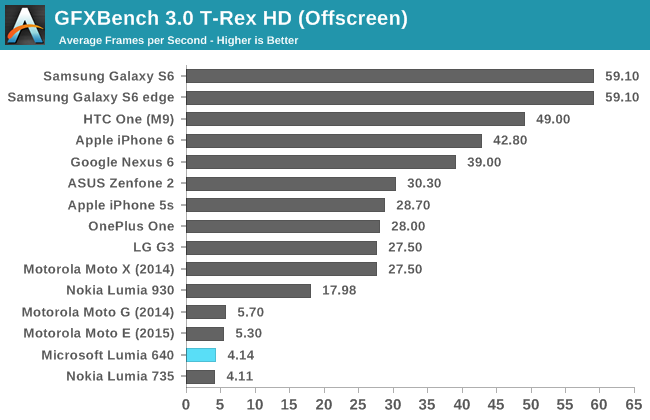
In both the on-screen and off-screen tests, the Lumia 640 lags behind the Moto G. While 1-2fps doesn’t seem like much, when your frame rate is in the low single digits it represents a significant difference in performance. Because of this, I decided to take a look at the performance in GFXBench’s driver overhead test to see what impact the GPU drivers and graphics API might have on performance.
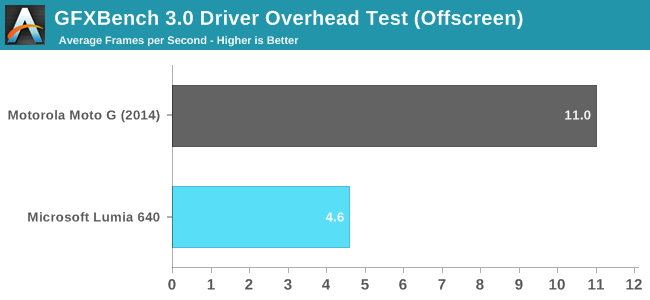
As suspected, there’s a very significant gap in performance when comparing the Lumia 640 to the Moto G. I can’t say whether this is due more to the differences between OpenGL and DirectX, or between the different Adreno drivers on Windows Phone and Android, but whatever the case may be the end result is a notable decrease in GPU performance on Windows Phone when compared to an Android device with the same SoC.
I’m not happy at all with the GPU performance that we see in low-end and even mid-range smartphones, and the Lumia 640 is no exception. There’s not much Microsoft can do here though, as moving to Snapdragon 410 with its Adreno 306 will not improve GPU performance at all. All I can really say is that users shouldn’t expect to be playing any 3D games on their Lumia 640, but simpler 2D games should run just fine.










130 Comments
View All Comments
kevloral - Tuesday, June 9, 2015 - link
"After declining sales of Symbian devices, the company decided to go all in with Microsoft's Windows Phone platform"Why is this false mantra repeated again and again? When Nokia decided to go Windows Phone, Symbian devices were being sold more than ever. Just check the statistics from the time.
danbob999 - Tuesday, June 9, 2015 - link
Declining market share.niva - Tuesday, June 9, 2015 - link
Nokia used to be to the cell phone market kind of what Apple has become today. It's amazing how quickly they failed and were never able to recover. Failing to jump on the Android bandwagon early ultimately led to their demise.Brandon Chester - Tuesday, June 9, 2015 - link
That's not true. Reports from Gartner and IDC both agree that Nokia shipped significantly fewer devices in each quarter of 2011 than that same quarter in 2010.hemedans - Tuesday, June 9, 2015 - link
last symbian flagship was nokia n8 which come out 2010, in 2011 n9 was nokia flagship and 2012 we saw lumia 900 and 920.last s60v3 were nokia c5 and e5 both of them come out 2010, elop killed symbian at low end in favour of nokia asha. symbian was killed by nokia before the official anouncement in 2012.
Cryio - Tuesday, June 9, 2015 - link
Last Symbian Flagship was the 808 which launched in 2012.hemedans - Wednesday, June 10, 2015 - link
808 was niche device to introduce nokia camera capability, at that time nokia already anounce symbian was dead platform. in 2012 nokia 900 and 920 were nokia flagshipPenti - Tuesday, June 9, 2015 - link
They had effectively already killed Symbian early 2011 and sales didn't decline until the burning platform memo, plus canceling already announced/showed phones and giving up on Symbian development, which they transfered to Accenture already in the summer which later fired almost everybody within a year or so. By the time the N9 was out/showed they had made it clear the platform (MeeGo/Harmattan) was dead before the phone shipped and wouldn't receive any major updates or any new development.Penti - Tuesday, June 9, 2015 - link
They didn't really have a WP device of their own until Lumia 900 either. Lumia 800 was a Clevo-built/designed device. Thus they had nothing to sell between feb 2011 and april-june 2012 at all that they hadn't decided to stop development of and spoken out against. Neither did they have a WP8 device until November 2012.Klimax - Saturday, June 13, 2015 - link
Sales at the cost of profits. They made near zero on them as they HAD to make them extremely cheap. Otherwise you'd see sales going down much sooner and much faster.Symbian was dead, it just didn't noticed it for short time...